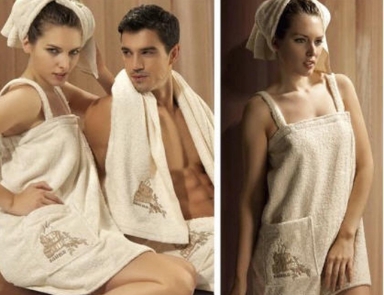What goes in the bath?
Doctors do not recommend wearing clothes in the sauna. Bathing suits, towels and even bedding are harmful for medical reasons.
Staying without clothes has a medical basis. The effect of high temperatures on the body causes intense sweating. Sweat not only removes excess fluid, but also protects the skin from overheating (the body cools off from sweat drops).
If there are clothing on the body, the sweat instantly absorbs and does not cool the skin. This may cause overheating. In young people with strong blood vessels, it can go away without consequences, but people who are overweight and hypertensive are at risk.
The Germans follow the recommendations that they should go naked in saunas (even public ones). Moreover, the first part of the rules that the guests of the German sauna will see is: "Von der Kleidung verboten" (Prohibited from clothing). Germans' democracy is not always appropriate. However, if you are the lucky owner of a sauna, then there are no restrictions for you and you can enjoy the sauna in any form.

It is mandatory for the sauna to cover head
The cap protects the head from overheating
Sauna hats are chosen exclusively from natural materials. Synthetics cannot cope with the functions of thermoregulation and does not protect the hair. The optimum properties are woolen fabrics - felt. Very thick, they retain heat well, which means that they do not allow the head to heat up in high temperatures.
Coarse, untreated flax behaves a little better. Higher density fabric retains temperature and thanks to its special composition has a pronounced antimicrobial and anti-inflammatory effect, absorbs moisture and cools the skin.
Proper fabrics for sauna clothing
The basis of textiles, from which all items of special wardrobe for saunas are sewn are cotton, linen and synthetic fibers.
Frotte fabric. It is made of cotton. Its surface consists of a pile (double or single free loop). The main advantages of the material: well absorbs moisture, breathes, gives a gentle massage effect.
Waffle cloth. It is also made of cotton, but by another method. As a result we get a canvas with square convex and concave cells. The structure of the material provides great absorption and breathability. Waffle fabric sewn products retain their shape.
Flax and fabrics at its base. A great advantage of flax is its high antibacterial properties. This is why flax is recommended for people with problematic skin. All significant material properties are revealed in the sauna. Here the fabric shows a unique ability to cool the skin at high temperatures and heat at low.
Microfiber. Synthetic polyester based material. It absorbs moisture and allows air to flow, is easy to dry and wash but is not intended for saunas - oils that rub into the skin penetrate deep into the fibers, after which the microfibers lose their properties.

Kilt and Pareo
Kilt is the traditional menswear of Scottish climbers. And as for the sauna wardrobe - a piece of fabric that is wrapped around the hips and fastened (elastic or Velcro). Kilt is a multifunctional thing. It can be put on a bench in a sauna or used as a blanket for a relaxation area. Pareos for women is an altered kilt that attaches not through the hips but through the chest. These clothes come from Tahiti. Although Tahitians wear these clothes even on their hips, a pareo variant has appeared in European society covering the entire body. Such models are suggested to us by saunas manufacturers.
Bathrobe
At the exit of the sauna you will need bathrobe. It will replace the uncomfortable towel and will be especially nice in a cold room. The standard cut for such clothing is kimono. Bathrobe has wide sleeves, instead of zippers or buttons, a belt is used. The collar is most often replaced by a deep hood that will not require you to wrap a towel around your head.
Towel
In the case of a sauna, towels are as diverse as kilt. You better bring a few towels with you. One will be used for changing rooms, the other for going to the sauna, the third for wiping skin after a shower or pool.
